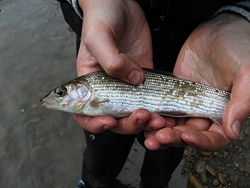Grayling (species)
| Grayling | |
|---|---|
 | |
| Conservation status | |
| Scientific classification | |
| Kingdom: | Animalia |
| Phylum: | Chordata |
| Class: | Actinopterygii |
| Order: | Salmoniformes |
| Family: | Salmonidae |
| Subfamily: | Thymallinae |
| Genus: | Thymallus |
| Species: | T. thymallus |
| Binomial name | |
| Thymallus thymallus (Linnaeus, 1758) | |
The grayling (Thymallus thymallus) is a species of freshwater fish in the salmon family (family Salmonidae) of order Salmoniformes. It is the type species of its genus. Native to the Palearctic ecozone, the grayling is widespread throughout northern Europe, from the United Kingdom and France to the Ural Mountains in Russia. While it was introduced to Morocco in 1948, it does not appear to have become established there.
Attributes
The grayling grows to a maximum recorded length of 60 cm (24 in) and a maximum recorded weight of 6.7 kg (15 lb). Of typical Thymallus appearance, the grayling proper is distinguished from the similar Arctic grayling (T. arcticus arcticus) by the presence of 5–8 dorsal and 3–4 anal spines, which are absent in the other species; T. thymallus also has a smaller number of soft rays in these fins. Individuals of the species have been recorded as reaching an age of 14 years.
The grayling prefers cold, clean, running riverine waters, but also occurs in lakes and, exceptionally, in brackish waters around the Baltic Sea. Omnivorous, the fish feeds on vegetable matter, as well as crustaceans, insects and spiders, molluscs, zooplankton, and smaller fishes, including Eurasian minnows and yellow perch. Grayling are also prey for larger fish, including the huchen (Hucho hucho).
With the Arctic grayling, T. thymallus is one of the economically important Thymallus species, being raised commercially and fished for sport.
The grayling is a protected species listed in appendix III of the Bern Convention.
The term "grayling" is often used to refer generically to the Thymallus species, and T. thymallus is sometimes called the European grayling for clarity. There are many obsolete synonyms for the species.
The generic name Thymallus derives from the Greek θύμαλλος, "thyme smell", a name derived from the fragrance of wild thyme that freshly caught graylings quite often have.[citation needed]
Angling

The grayling is known as the 'lady of the stream'.[1] They used to be persecuted by anglers for the ability to stop trout colonising stretches of rivers and streams. They are largely a shoal species and therefore can out-compete the more individual trout.
In England and Wales they can be fished for throughout the coarse fishing season (16 June to 14 March), providing thrilling sport on the fly when the trout season is closed. There is no closed season for grayling in Scotland. There are no grayling in Ireland. Well known grayling flies include: the grayling witch, klinkhamers, czech nymphs and 'red tags' along with other trout patterns. Flies tied to resemble small pink shrimps have also been found to be useful.
In France too the season is limited depending upon several factors. The Allier River is one of the rare places in Southern Europe where the common grayling occurs in a natural habitat.[2] This fish is much valued in French gastronomy for its fine and delicate texture and is best eaten along with a light wine.[3]
See also
References
- World Conservation Monitoring Centre (1996). Thymallus thymallus. 2006. IUCN Red List of Threatened Species. IUCN 2006. www.iucnredlist.org. Retrieved on 5 May 2006.
- Froese, Rainer and Pauly, Daniel, eds. (2004). "Thymallus thymallus" in FishBase. October 2004 version.
- "Thymallus thymallus". Integrated Taxonomic Information System. Retrieved 11 December 2004.
